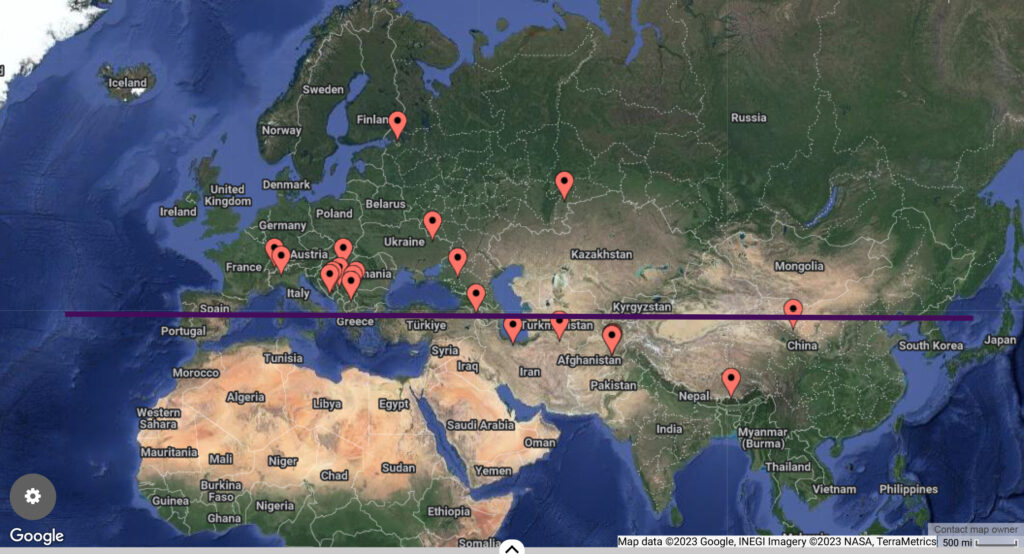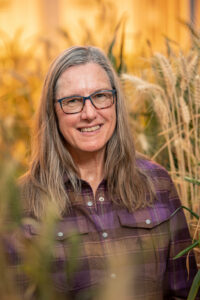By Kimberly Garland Campbell
In the dark days of winter, January through February, those of us who work with winter wheat begin to wonder how the plants are faring through the cold temperatures. Wheat is widely grown at latitudes between 20 to 60 degrees north and -20 to -40 degrees south. Climate change is predicted to expand the range of wheat into higher and lower latitudes. Because of this wide geographic distribution, wheat has evolved to survive in many climate zones, and winter wheat must survive severe freezing temperatures.
The first wheat grown in the Pacific Northwest (PNW) was soft red winter wheat from the East Coast of the U.S., and spring club wheat from California and Chile. Winter survival was one of the first problems tackled by early wheat breeders in the region. Jasper Spillman, Washington State University’s (WSU) first wheat breeder, crossed the spring club wheat, Little Club, by the winter-hardy hard winter wheat, Turkey, to select for greater winter survival. Subsequent breeders in the U.S. and Canada assessed many wheat cultivars and landraces from around the world to improve the winter survival of winter wheat.
In 2021, Ukraine was the fifth largest exporter of wheat, accounting for over 8% of the total. Before that, wheat varieties from Ukraine played an important role in the establishment of winter wheat around the world, particularly in North America. Various versions of Turkey wheat were imported to North America by Mennonites emigrating from Crimea and other parts of modern-day Ukraine and Russia in the 1870s. The wheat was grown under as many as 28 synonyms, and all were not identical. The Turkey wheats had better winter hardiness compared to the eastern soft wheats and were more productive in the soils of the Great Plains.
Turkey wheat types were widely used in the early hard wheat breeding programs in the Great Plains to improve winter hardiness and agronomic adaptation, but many people don’t realize that they are also ancestors of the PNW soft and hard winter wheat breeding programs. This is partly due to Spillman’s earliest crosses and to recurring crosses by other wheat breeders including Orville Vogel. The Turkey wheats were used in winter wheat breeding programs throughout the world. Turkey is a parent of both the Japanese variety, Norin 10, and Vogel’s soft white variety, Brevor, so it’s represented in the Norin 10/Brevor semidwarf selections developed by Vogel. Another Ukrainian winter wheat, Kharkov, became widely grown in the Great Plains. It was collected from the Luhansk region of eastern Ukraine. We still grow it as a long-term check in the U.S. Department of Agriculture’s Cooperative Wheat Regional Nurseries.

We have evaluated wheat cultivars and landraces from around the world and the PNW using artificial freezing trials conducted at the WSU Plant Growth Facility. The most freezing tolerant winter wheat in North America is from the breeding programs located at Saskatoon, Canada, and those at Montana State University, North Dakota State University and South Dakota State University. The Canadian Western Red winter wheat, Norstar, developed at the Agriculture Canada Research Station in Lethbridge, Alberta, was a great advance in winter survival when it was released. We have recorded survival down to -20 C in our tests, and we use it as our resistant check. In contrast, many PNW breeding lines have poor survival at -15 C. Norstar is included in the pedigree of the most freezing tolerant winter wheat cultivars from Montana and the Dakotas. Its pedigree is Winalta/Alabaskaya. Winalta has Turkey Red and other Turkey types in its pedigree. Alabaskaya is a cultivar attributed to Kazakhstan. Mironovskaja 808, from Ukraine, was also used as a source of winter hardiness.
In a recent study at WSU, then-graduate student Jinita Sthapit Kandel worked with Deven See and Dan Skinner to rate the response to freezing from 533 wheat landraces from around the world. Their analysis discovered distinct genetic differences in winter wheat adapted to latitudes above 40 degrees north. Specific gene regions were identified that were associated with cell membrane stability. The most freezing tolerant winter wheat landraces were from Ukraine and Russia and the mountainous areas of Europe.
Plants are more tolerant to freezing while in the vegetative stage. Reproductive growth in winter wheat begins with jointing. Exposure to freezing temperatures after jointing damages wheat flowers and grain yield. Therefore, wheat and many other plants have fine-tuned their switch from vegetative to reproductive phases of growth to match the prevailing environment using vernalization (response to cold) and photoperiod (response to daylength). Plants that survive through freezing temperatures in the winter adapt using genetic pathways that respond to temperature and daylength. The master switches controlling vegetative to reproductive growth are the vernalization genes on the wheat group 5 chromosomes and the photoperiod genes on the wheat group 2 chromosomes.
Winter wheat has recessive vernalization (vrn) genes indicating that a period of near-freezing temperature is required before the plants will enter the reproductive stage and flower. Adapted wheat in our region requires six to eight weeks of exposure to near-freezing temperatures before flowering. The dominant Vrn-1 gene, which is present in spring wheat, eliminates this cold requirement.
The photoperiod (ppd) genes regulate wheat flowering in response to lengthening days. A mutation in the ppd-1 gene to the dominant Ppd-1 eliminates the photoperiod response. In the PNW, most of our winter and spring wheat is photoperiod sensitive. There is variation within photoperiod sensitive winter wheat, which requires lengthening days and exposure to cold to flower.
The specific amount of vernalization and daylength required are fine-tuned to match the climate. For example, winter wheat grown in Oregon will begin to flower earlier in the spring after less vernalization and at shorter days than wheat adapted to northern Washington. Even if the temperatures warm, winter wheat cultivars like Eltan and Otto will remain prostrate in the vegetative stage until the correct daylength is present.
In response to cold, wheat and other plants also use the c-repeat binding factor (CBF) pathway. Wheat gene names can be cryptic; the main point is that the CBF genes are transcription factors that control the expression of many other genes to protect cell membranes in response to freezing. They work together with the vernalization and photoperiod genes.
All of these genes exhibit copy number variation and are frequently duplicated or even present in triplicate in some wheat lines. Copy number variation is defined as deletions, insertions and duplications of genes and noncoding DNA. Copy number variants form rapidly in response to stress. While each variant generates moderate changes, they can add up over time.
We discovered that copy number variation at the CBF and Vrn genes was associated with freezing tolerance in wheat. The gene expression at the CBF and Vrn genes was highest for the most frost tolerant lines, like Norstar. Norstar and Eltan, a freeze tolerant PNW winter wheat, had up to three copies of each of the resistant alleles at each gene.
The expansion of wheat into new latitudes required a series of small evolutionary changes in gene expression and adaptation. Apparently, as wheat was gradually brought from its center of origin in modern-day Turkey, up through the Caucasus and Ukraine and out into Europe and Asia, these copy number variants became established. The Mennonites brought these same wheat variants from Ukraine to North America, establishing the genetic foundation for winter survival in wheat production regions throughout the world.
Our current challenge as winter wheat breeders is to adapt new cultivars to warming, high-latitude environments. The plants lose valuable growing time when the spring temperatures are warm enough for green-up, but they sit and wait for longer days.
As we learn more about control of the vernalization, photoperiod and CBF pathways and their interactions, we have better tools to develop new cultivars for future growing conditions.
References:
Sthapit Kandel, J., Huang, M., Zhang, Z., Skinner, D.Z. and See, D.R., 2018. Genetic diversity of clinal freezing tolerance variation in winter wheat landraces. Agronomy, 8(6), p.95.
Zhu, J., Pearce, S., Burke, A., See, D.R., Skinner, D.Z., Dubcovsky, J. and Garland-Campbell, K., 2014. Copy number and ha
plotype variation at the VRN-A1 and central FR-A2 loci are associated with frost tolerance in hexaploid wheat. Theoretical and Applied Genetics, 127(5), pp.1183-1197.
Quisenberry, K.S. and Reitz, L.P., 1974. Turkey wheat: The cornerstone of an empire. Agricultural History, 48(1), pp.98-110.
Würschum, T., Boeven, P.H., Langer, S.M., Longin, C.F.H. and Leiser, W.L., 2015. Multiply to conquer: copy number variations at Ppd-B1 and Vrn-A1 facilitate global adaptation in wheat. BMC genetics, 16(1), pp.1-8.
This article originally appeared in the February 2023 issue of Wheat Life Magazine.

Kimberly Garland Campbell, Ph.D.
Kimberly Garland Campbell, Ph.D., is a USDA plant research geneticist and club wheat breeder at the USDA-ARS in Pullman, Washington. Her research focuses on genetics and breeding of wheat responses to abiotic and biotic stress; breeding wheat for winter survival; enhancing quality, functionality and marketability in the in the western U.S. of soft white and club wheat; and control of rusts of cereal crops. Read more about Dr. Campbell..
